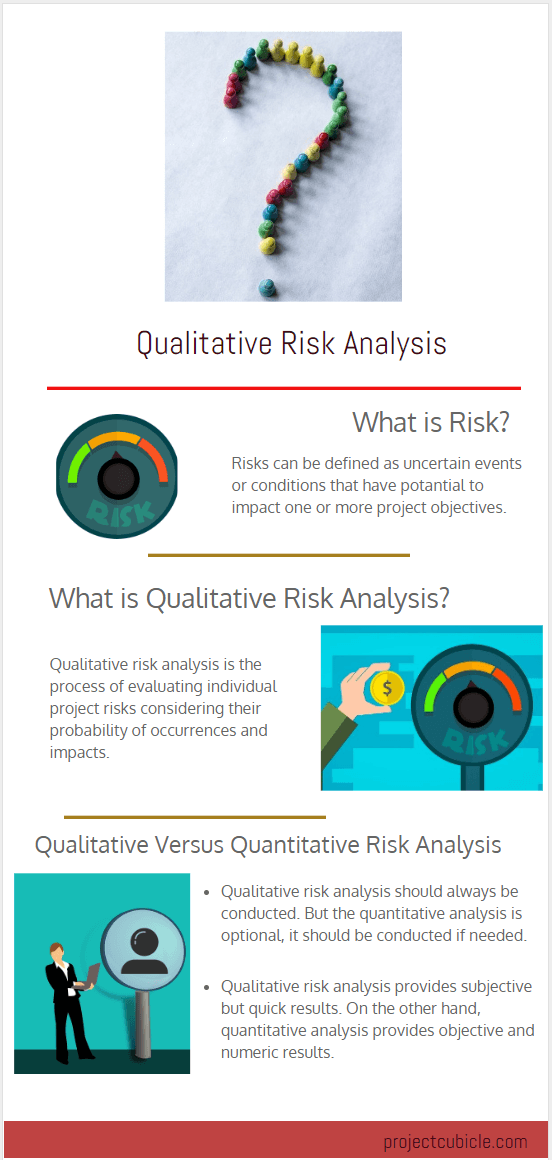Table of Contents
What is Risk?
Before talking about perform a qualitative risk analysis process, let’s answer “what is risk?”. Typically, Risks can be defined as uncertain events or conditions that have the potential to impact one or more project objectives. Those impacts on various project elements (such as schedule, budget, scope, quality) or goals may be positive or negative. If the risks are positive, you need to establish risk response strategies for positive risks. If they are negative, risk response strategies for negative risks should be developed to mitigate their impact.
What is Qualitative Risk Analysis Definition?
- Identifying Risks
- Analyzing Risks
- Selecting Risk Responses
- Monitoring and Controlling
The planning process group of project risk management knowledge area includes two processes for risk analysis. Qualitative risk analysis is the process of evaluating individual project risks considering their probability of occurrences and impacts. As a result of analysis groups, project risks can be classified into three groups according to their degree of impact which are low, medium, and high.
Basically, risks may impact various elements and tasks of a project. Project schedule, project scope, resource availability, and project goals may be affected as a result of a poorly conducted risk management process.
The probability of risk can be graded using numbers (0 to 1) or percentages (%0 – %100). Using the same scale helps organizations to make comparisons between the same kind of projects and project risks.
Qualitative risk analysis does not only evaluate risks by using a scale, but also group them considering their source and impacts on the project goals and elements.
Types of Analysis
Various types of project requirements are factors on selecting the type of qualitative risk analysis. Availability of time, resources and experience also influence the decision of how to perform project risk assessment. Below are five common types of qualitative risk analysis;
- Probability/Impact Matrix
- Bow-Tie Analysis
- Delphi Technique
- SWIFT Analysis
- Pareto Analysis
Main Purpose
Projects often include a large number of risks that have the potential to affect project goals. The main purpose of the qualitative risk analysis is to prioritize risks considering their probability of occurrence and degree of impact. Because it is difficult for a project manager to deal with every single risk and spend resources to mitigate them. Evaluating risks helps team members to develop risk response strategies and use the resources at an optimum level to deal with them.
In addition to that, conducting perform qualitative risk analysis process provides a common understanding among team members while devising the most appropriate risk response strategies.
Qualitative Versus Quantitative Risk Analysis
Project managers often conduct qualitative risk analysis because it is quicker than quantitative risk analysis. However, in some cases, they should conduct a quantitative risk analysis to understand the risks in detail. Imagine yourself sitting in front of a doctor to talk about your health report. If the doctor asks you questions regarding your health, this is a qualitative analysis. But if he analyzes the amount of glucose in your blood by checking the report, this is a qualitative analysis. Because he quantifies the inputs for decision making.
Below are the difference between qualitative and quantitative risk analysis;
- Qualitative risk analysis should always be conducted. But the quantitative analysis is optional, it should be conducted if needed.
- Qualitative risk analysis provides subjective but quick results. On the other hand, the quantitative analysis provides objective and numeric results.
Qualitative Risk Analysis Examples
Various tools can be used to perform a qualitative risk analysis that takes a varying amount of time. You can select one of them considering your project requirements. A Risk Assessment Matrix (RAM) is a useful tool that helps you to rate project risks as low, medium, high, very high. You start by defining the rating scales for probability and impact to use that tool. Below is an example Probability Scale.

And, below is an example Impact Scale.

As shown in the tables above, 5 is the highest probability and impact. Multiplying probability by impact gives us a risk score. For instance, if the probability of a risk is 4 and its impact is 5, then the risk score will be 20 (4×5).
This tool can be applied to both positive and negative risks.
Conclusion
Many project management professionals don’t know the main reason that they should conduct project risk management processes. In this article, we talked about quantitative and qualitative risk analysis definitions, tools, and examples to help aspirants planning to take the PMP or CAPM Certification Exam. We make a comparison of these risk management concepts that may appear on the PMP and CAPM Exams. We hope that it will be useful for professionals who are seeking to build up a career as a risk manager.
Further Reading

Francois Simosa is the head of training for the Gragados Training Associates, which provides special project management and risk management training programs.
















Qualitative Risk may not seem as important as Quantitative Risk because it does not include money, it is actually as important as it.
ı wasn’t have information about this topic thank you , ı’m following all your articles 🙂